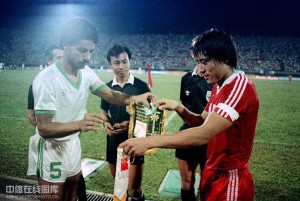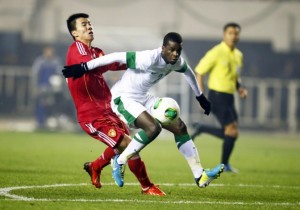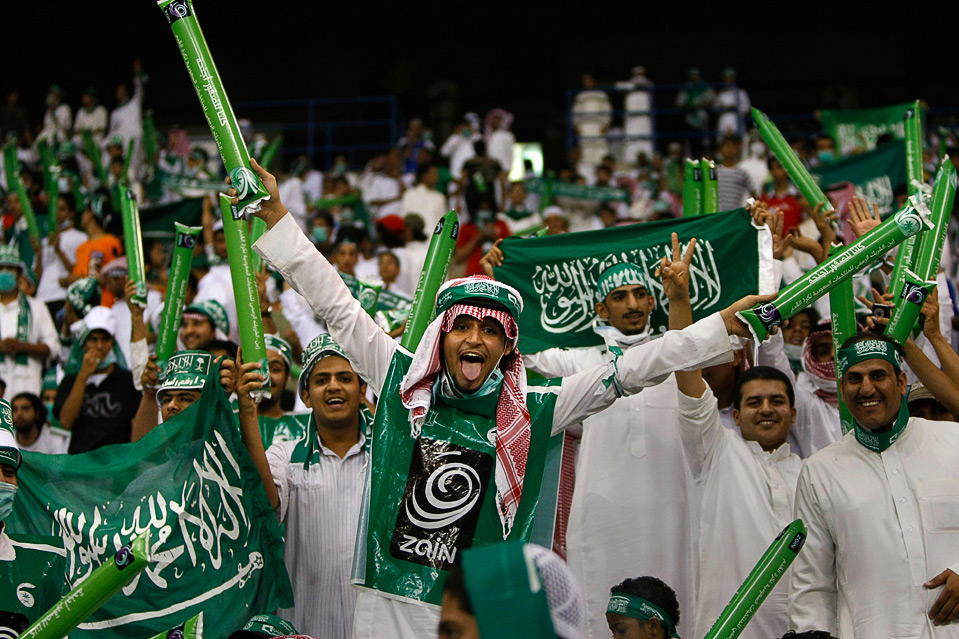Having qualified for the Asian Cup in comically inept fashion, China were pretty much handed as kind a group stage draw a third seeded team could possibly get. Saudi Arabia, Uzbekistan and North Korea await Guozu in a group B that they have every possible chance of qualifying from. The bad news is, a quarter-final with much tougher prospects Australia or South Korea is likely to await the Chinese should they finish among the top two – but let’s not get ahead of ourselves. Over the next week we will be bringing you the lowdown on each of China’s group stage opponents – starting with The Kingdom of Saudi Arabia.
Major Tournament History
Saudi Arabia’s defining moment in global football came in 1994 when they made it to the second round of their first ever World Cup courtesy of a spectacular individual goal from Saeed Al-Owairan. Al-Owairan, dribbling from his own half, sliced apart a highly rated Belgian defence before slotting home and celebrating with the same level of vigour he had used in scoring the goal.
It is a moment which remains etched in the minds of many who saw it but, unfortunately for the Saudis, it also marked their footballing nadir beyond the boundaries of Asia. They were eliminated by Sweden in the last sixteen and an impressive three consecutive qualifications for the subsequent World Cups yielded a trio of group stage eliminations most notable for an 8-0 tonking at the hands of Germany in 2002 which saw Miroslav Klose bag a quarter of his record breaking 16 World Cup goals.
However, despite being one hit wonders on the world stage, the Green Falcons have an excellent pedigree within their own continent. Of the eight editions of the Asian Cup finals they have participated in, the Saudis have made it to the final on six occasions and lifted the trophy three times. They made every final between 1984 and 2000, but have faltered in the group stages in two of the last three editions of the tournament – including the 2011 competition in Qatar where they fell to also-rans Syria and Jordan before being hammered 5-0 by Japan. Despite recent problems, only Japan have won more Asian Cups than the Saudis and they have made it to the final more than any other side.
How they made it to Australia
As they usually do, the Saudis breezed through qualification with five wins, one draw and no defeats to top a group including Iraq, Indonesia and…ahem…China. The only points they dropped were in a 0-0 draw against the Chinese in Xi’an (more on that later) and they conceded just three goals in six matches.
Recent news and form
Despite their comfortable qualification, The Green Falcons go into the Asian Cup in some degree of turmoil. Following defeat in the Gulf Cup of Nations final to Qatar in late November, Spanish Head Coach Juan Ramon Lopez Caro was let go and eventually replaced by Romanian Cosmin Olaroiu in mid-December. Caro won just ten of his twenty-one games in charge (including some embarrassing friendly losses against Moldova and Georgia) but, if the Gulf Cup of Nations is considered a legitimate tournament, the defeat by Qatar was the Spaniard’s only competitive loss in fifteen matches and so it seems like a strange decision to make such a dramatic change so close to a major tournament.
Having won the league with clubs in Saudi Arabia, Qatar and the UAE, Caro’s replacement has an excellent reputation on the Arabian Peninsula but he hasn’t had the most auspicious start to his international coaching career. Olaroiu’s first game in charge was a 4-1 defeat at the hands of Bahrain, who they had beaten 3-0 a month earlier in the Gulf Cup of Nations, and his second was a 2-0 loss against South Korea in their final warm-up game before the tournament begins. As the uncompetitive nature of China’s most recent warm-up games show, it would be wrong to read too much into these results, but the upheaval prior to the tournament is clearly having an effect on Olaroiu’s side and there is a negative aura surrounding them ahead of the big kick off.
Players to watch
As is the norm with Saudi sides, all of their players are domestically based with only five clubs represented in the 23-man squad. Among these, it will be no surprise to learn that the team with the most players is Asian Champion’s League finalists Al-Hilal, and it is one of their number, Nasser Al-Shamrani, who will be the most interesting to observe on January 10th for more than just footballing reasons.
That Al-Shamrani is Asia’s player of the year for 2014 is reason enough to pay attention to the forward’s exploits but, much like a certain Uruguayan, it’s his extra-curricula activity which will make him truly stand out in Australia. Prior to West Sydney Wanderers’ meeting with Al-Hilal in the Asian Champion’s League final in November, few football fans Down Under would have known much about the 31-year-old.

Embrace The Hate: Asian player of the year, Nasser Al-Shamrani will need to be ready for abuse from Australian fans
However, in the aftermath of a bad tempered second leg which saw Al-Hilal lose 1-0 on aggregate, Al-Shamrani reportedly spat at and head-butted Wanderers’ player Mathew Spiranovic. He was given a six game Champion’s League ban for his conduct but, to make matters worse, the former Al-Shabab player reportedly lashed out and shoved a fan who was heckling him prior to Saudi Arabia’s 4-1 loss to Bahrain in Australia in December. Al-Shamrani’s dangerous attacking play and goal scoring prowess is something worthy of observing in itself, but it will also be interesting to see how the temperamental Saudi responds to the inevitable barracking he will receive from the Australians in attendance when they face China in Brisbane.
Among the other players to look out for are veteran defensive midfielder Saud Kariri who will go into the tournament as captain with 125 caps under his belt (or on his head?) and diminutive 24-year-old attacking midfielder Nawaf Al-Abed who was named player of the tournament in November’s Gulf Cup of Nations.
History vs China
In the seventeen meetings the sides have had since 1978, the Saudis shade the win column seven to six but this belies more worrying trends in the contests between the two sides. Their most recent meetings came in qualifying for this tournament where Saudi Arabia won their home match 2-1 in February 2013 before being held to a 0-0 draw in Xi’an nine months later. Their only other meeting of the last ten years came in a friendly in Tianjin back in 2009 in which the Saudis ran out comfortable 4-1 winners.

Good Times: China may have lost the 1984 Asian Cup final to Saudi Arabia, but at least they got that far
Perhaps even more disconcerting for the Chinese is their record against the Green Falcons at the Asian Cup itself. The teams met four straight times between 1984 and 1996 and it never ended well for the East Asians. In 1984 they clashed in the final in Singapore where the Saudis won 2-0 and four years later they met in a group stage game in Qatar in which China lost 1-0 but qualified for the semi-finals anyway. In 1992, the Chinese got their only positive Asian Cup result against the Saudis when they held them to a 1-1 draw in the opening group game of the tournament in Japan. Their final meeting came in the quarter-finals of the 1996 competition in the UAE which saw China streak to a 2-0 lead within sixteen minutes only to capitulate and wind up on the wrong end of a 4-3 defeat to a team on course for their last Asian Cup triumph.
Prospects for the game and predictions

Familiar Foes: The teams met twice during qualification, but the result might be different this time around
Recent history suggests that Saudi Arabia should be favourites for this match, but there are plenty of signs to suggest that China can get at least a point in their opening group game. A draw was the outcome the last time these two met just over a year ago and while Guozu have been on a slight upward curve over the last few months under Alain Perrin, their opponents have fallen into disarray with a late coaching change and three straight defeats.
Under normal circumstances, it would be wise to concede that China will probably succumb to their Arab opposition but even the Saudi’s Head Coach appears to lack faith in his side. Following their defeat to South Korea on January 4th, Olaroius made a series of statements about his team’s physical condition that sound like ready made excuses for poor results in the tournament.
After complaining that “it’s hard to recover, to be fresh for the start of the competition” the Romanian went on to say “I hope in the next game they will look better and better.” The next game is against China and if any more evidence is needed that Olaroiu is getting his excuses in early, he also pessimistically stated that “to prepare will be impossible in terms of the physical condition over a couple of days.”
It looks like the Green Falcons have big problems and, whatever the pedigree of their coach, these are going to be difficult to overcome. As is often the case with the opening game of a tournament – especially when between the two teams likely to be competing for second place – this looks like being a low scoring, cagey affair. Under Perrin, China don’t concede many goals, but they also struggle to score against opposition on a comparative level. A 0-0 draw seems like a realistic prospect here, but if this correspondent was to stick his neck out, he would say that China will nick it by a single goal.
Prediction – China to win a tight game 1-0.
(China vs Saudi Arabia live from Brisbane kicks off at 5pm Beijing Time and can be seen on CCTV5 or www.letv.com)



Fantastic result for the team which rode its luck but also outplayed the Saudis for much of the first half and weren’t overly threatened by a lacklustre Saudi attack.
Wang Dalei deserving of the player of the match award, but Hao Junmin and Zheng Zhi had good games too I thought.